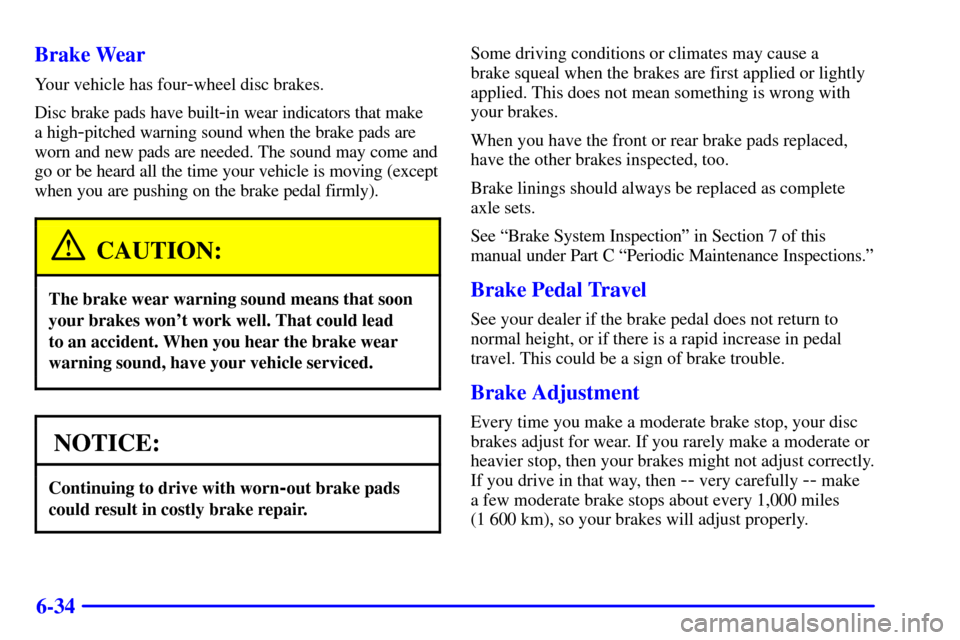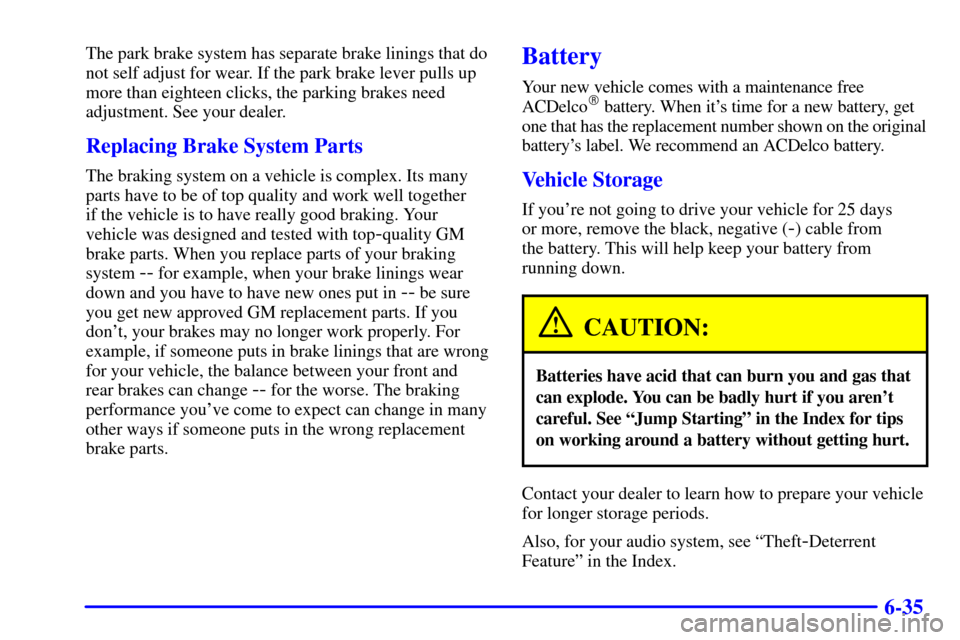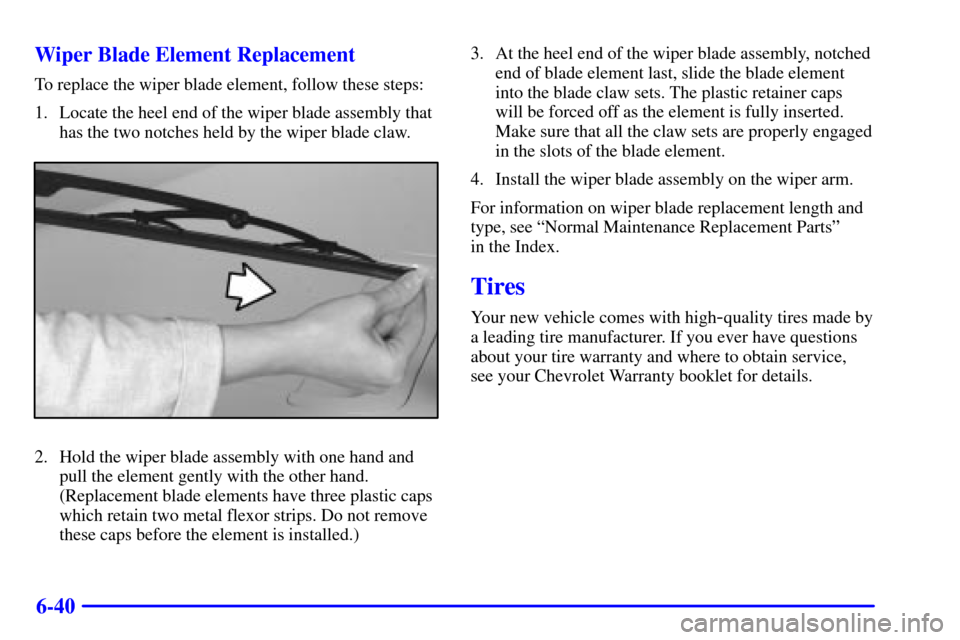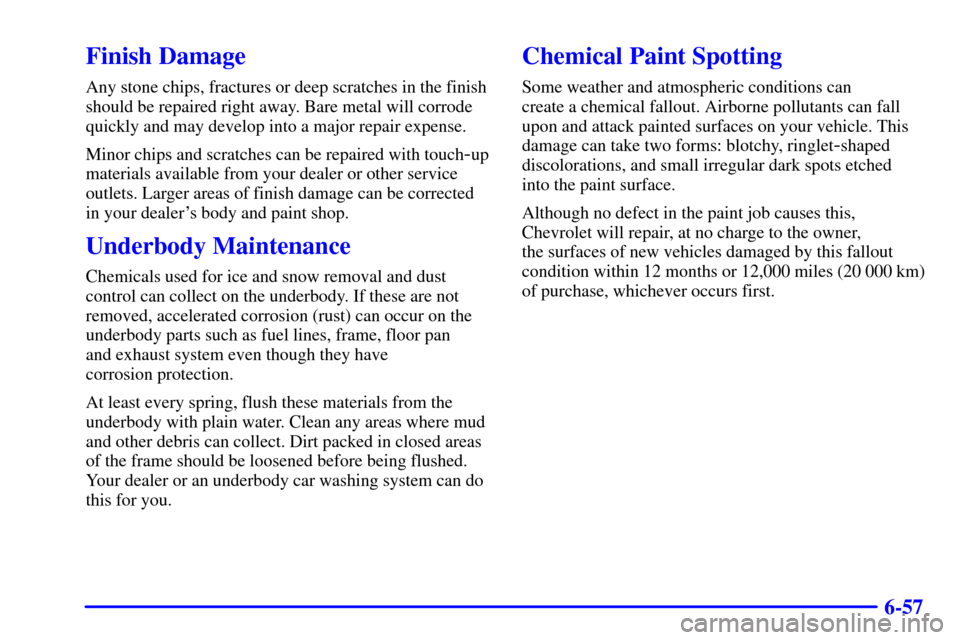Page 285 of 357

6-34 Brake Wear
Your vehicle has four-wheel disc brakes.
Disc brake pads have built
-in wear indicators that make
a high
-pitched warning sound when the brake pads are
worn and new pads are needed. The sound may come and
go or be heard all the time your vehicle is moving (except
when you are pushing on the brake pedal firmly).
CAUTION:
The brake wear warning sound means that soon
your brakes won't work well. That could lead
to an accident. When you hear the brake wear
warning sound, have your vehicle serviced.
NOTICE:
Continuing to drive with worn-out brake pads
could result in costly brake repair.
Some driving conditions or climates may cause a
brake squeal when the brakes are first applied or lightly
applied. This does not mean something is wrong with
your brakes.
When you have the front or rear brake pads replaced,
have the other brakes inspected, too.
Brake linings should always be replaced as complete
axle sets.
See ªBrake System Inspectionº in Section 7 of this
manual under Part C ªPeriodic Maintenance Inspections.º
Brake Pedal Travel
See your dealer if the brake pedal does not return to
normal height, or if there is a rapid increase in pedal
travel. This could be a sign of brake trouble.
Brake Adjustment
Every time you make a moderate brake stop, your disc
brakes adjust for wear. If you rarely make a moderate or
heavier stop, then your brakes might not adjust correctly.
If you drive in that way, then
-- very carefully -- make
a few moderate brake stops about every 1,000 miles
(1 600 km), so your brakes will adjust properly.
Page 286 of 357

6-35
The park brake system has separate brake linings that do
not self adjust for wear. If the park brake lever pulls up
more than eighteen clicks, the parking brakes need
adjustment. See your dealer.
Replacing Brake System Parts
The braking system on a vehicle is complex. Its many
parts have to be of top quality and work well together
if the vehicle is to have really good braking. Your
vehicle was designed and tested with top
-quality GM
brake parts. When you replace parts of your braking
system
-- for example, when your brake linings wear
down and you have to have new ones put in
-- be sure
you get new approved GM replacement parts. If you
don't, your brakes may no longer work properly. For
example, if someone puts in brake linings that are wrong
for your vehicle, the balance between your front and
rear brakes can change
-- for the worse. The braking
performance you've come to expect can change in many
other ways if someone puts in the wrong replacement
brake parts.
Battery
Your new vehicle comes with a maintenance free
ACDelco� battery. When it's time for a new battery, get
one that has the replacement number shown on the original
battery's label. We recommend an ACDelco battery.
Vehicle Storage
If you're not going to drive your vehicle for 25 days
or more, remove the black, negative (
-) cable from
the battery. This will help keep your battery from
running down.
CAUTION:
Batteries have acid that can burn you and gas that
can explode. You can be badly hurt if you aren't
careful. See ªJump Startingº in the Index for tips
on working around a battery without getting hurt.
Contact your dealer to learn how to prepare your vehicle
for longer storage periods.
Also, for your audio system, see ªTheft
-Deterrent
Featureº in the Index.
Page 290 of 357
6-39
3. Turn the bulb and socket counterclockwise and
gently pull out.
4. Reverse the steps with a new bulb.
Windshield Wiper Blade Replacement
Windshield wiper blades should be inspected at least twice
a year for wear or cracking. See ªWiper Blade Checkº in
Section 7 of this manual under Part B ªOwner Checks and
Servicesº for more information.Replacement blades come in different types and are
removed in different ways. For the proper type and
length, see ªNormal Maintenance Replacement Partsº
in the Index.
1. Pull the windshield wiper arm away from the windshield.2. Push the release lever and slide the wiper assembly
toward the driver's side of the vehicle.
3. Install a new blade by reversing Steps 1 and 2.
Page 291 of 357

6-40 Wiper Blade Element Replacement
To replace the wiper blade element, follow these steps:
1. Locate the heel end of the wiper blade assembly that
has the two notches held by the wiper blade claw.
2. Hold the wiper blade assembly with one hand and
pull the element gently with the other hand.
(Replacement blade elements have three plastic caps
which retain two metal flexor strips. Do not remove
these caps before the element is installed.)3. At the heel end of the wiper blade assembly, notched
end of blade element last, slide the blade element
into the blade claw sets. The plastic retainer caps
will be forced off as the element is fully inserted.
Make sure that all the claw sets are properly engaged
in the slots of the blade element.
4. Install the wiper blade assembly on the wiper arm.
For information on wiper blade replacement length and
type, see ªNormal Maintenance Replacement Partsº
in the Index.
Tires
Your new vehicle comes with high-quality tires made by
a leading tire manufacturer. If you ever have questions
about your tire warranty and where to obtain service,
see your Chevrolet Warranty booklet for details.
Page 294 of 357
6-43
The purpose of regular rotation is to achieve more
uniform wear for all tires on the vehicle. The first
rotation is the most important. See ªScheduled
Maintenance Servicesº in the Index for scheduled
rotation intervals.
If you don't have P245/50ZR16 Goodyear Eagle GS-C
tires or P275/40ZR17 Goodyear Eagle F1
-GS tires, use
the rotation pattern shown above for your tires.
If you have P245/50ZR16 Goodyear Eagle GS-C tires
or P275/40ZR17 Goodyear Eagle F1
-GS tires, they
must roll in a certain direction for the best overall
performance. The direction is shown by an arrow on the
sidewall. Because these tires are directional, they should
be rotated as shown here. These tires should only be
moved from front to rear and rear to front on the same
side of the vehicle.
Page 308 of 357

6-57
Finish Damage
Any stone chips, fractures or deep scratches in the finish
should be repaired right away. Bare metal will corrode
quickly and may develop into a major repair expense.
Minor chips and scratches can be repaired with touch
-up
materials available from your dealer or other service
outlets. Larger areas of finish damage can be corrected
in your dealer's body and paint shop.
Underbody Maintenance
Chemicals used for ice and snow removal and dust
control can collect on the underbody. If these are not
removed, accelerated corrosion (rust) can occur on the
underbody parts such as fuel lines, frame, floor pan
and exhaust system even though they have
corrosion protection.
At least every spring, flush these materials from the
underbody with plain water. Clean any areas where mud
and other debris can collect. Dirt packed in closed areas
of the frame should be loosened before being flushed.
Your dealer or an underbody car washing system can do
this for you.
Chemical Paint Spotting
Some weather and atmospheric conditions can
create a chemical fallout. Airborne pollutants can fall
upon and attack painted surfaces on your vehicle. This
damage can take two forms: blotchy, ringlet
-shaped
discolorations, and small irregular dark spots etched
into the paint surface.
Although no defect in the paint job causes this,
Chevrolet will repair, at no charge to the owner,
the surfaces of new vehicles damaged by this fallout
condition within 12 months or 12,000 miles (20 000 km)
of purchase, whichever occurs first.
Page 318 of 357

6-67 Engine Specifications
Type
VIN Engine Code K V6. . . . . . . . . . . . . . . . . . . . . .
VIN Engine Code G V8. . . . . . . . . . . . . . . . . . . . . .
Fuel DeliveryFuel Injection . . . . . . . . . . . . . . . . . . .
Valve ArrangementIn
-Head . . . . . . . . . . . . . . . . . . .
Displacement
3800 V6 231 cubic inches (3791 cc). . . . . . . . . . . . .
5.7L V8 346 cubic inches (5665 cc). . . . . . . . . . . . .
Firing Order
3800 V6 1
-6-5-4-3-2 . . . . . . . . . . . . . . . . . . . . . . . .
5.7L V8 1
-8-7-2-6-5-4-3 . . . . . . . . . . . . . . . . . . . . .
Wheel Nut Torque100 lb
-ft (140 N´m) . . . . . . . . . .
Thermostat Temperature Specification
3800 V6 195�F (91�C) . . . . . . . . . . . . . . . . . . . . . . .
5.7L V8 180�F (82�C) . . . . . . . . . . . . . . . . . . . . . . .
Normal Maintenance
Replacement Parts
Engine Air Cleaner/FilterA917C . . . . . . . . . . . . . . .
Battery75
-60 . . . . . . . . . . . . . . . . . . . . . . . . . . . . . . . .
Engine Oil Filter
3800 V6 PF47. . . . . . . . . . . . . . . . . . . . . . . . . . . . . .
5.7L V8 PF44. . . . . . . . . . . . . . . . . . . . . . . . . . . . . . Fuel Filter
3800 V6 G627. . . . . . . . . . . . . . . . . . . . . . . . . . . . . .
5.7L V8 GF578. . . . . . . . . . . . . . . . . . . . . . . . . . . . .
PCV Valve
3800 V6 CV892C. . . . . . . . . . . . . . . . . . . . . . . . . . .
5.7L V8 CV948C. . . . . . . . . . . . . . . . . . . . . . . . . . .
Radiator CapRC24 . . . . . . . . . . . . . . . . . . . . . . . . . .
Spark Plug
3800 V6 41
-921 (0.060 inch gap) . . . . . . . . . . . . . . .
5.7L V8 41
-952 (0.060 inch gap) . . . . . . . . . . . . . . .
Windshield Wiper Blade Replacement
Type Hook. . . . . . . . . . . . . . . . . . . . . . . . . . . . . . . . .
Length 24.0 inches (60.1 cm). . . . . . . . . . . . . . . . . .
Vehicle Dimensions
Length193.5 inches (491.5 cm) . . . . . . . . . . . . . . . . .
Width74.1 inches (188.3 cm) . . . . . . . . . . . . . . . . . . .
Height
Coupe 51.3 inches (130.3 cm). . . . . . . . . . . . . . . . .
Convertible 52.0 inches (131.2 cm). . . . . . . . . . . . .
Wheelbase101.1 inches (256.6 cm) . . . . . . . . . . . . . .
Tread
Front 60.7 inches (154.2 cm). . . . . . . . . . . . . . . . . .
Rear 60.6 inches (154.0 cm). . . . . . . . . . . . . . . . . . .
Page 319 of 357
7-
7-1
Section 7 Maintenance Schedule
This section covers the maintenance required for your vehicle. Your vehicle needs these services to retain its safety,
dependability and emission control performance.
7
-2 Introduction
7
-4 Part A: Scheduled Maintenance Services
7
-5 Scheduled Maintenance
7
-17 Part B: Owner Checks and Services7
-21 Part C: Periodic Maintenance Inspections
7
-23 Part D: Recommended Fluids and Lubricants
7
-25 Part E: Maintenance Record